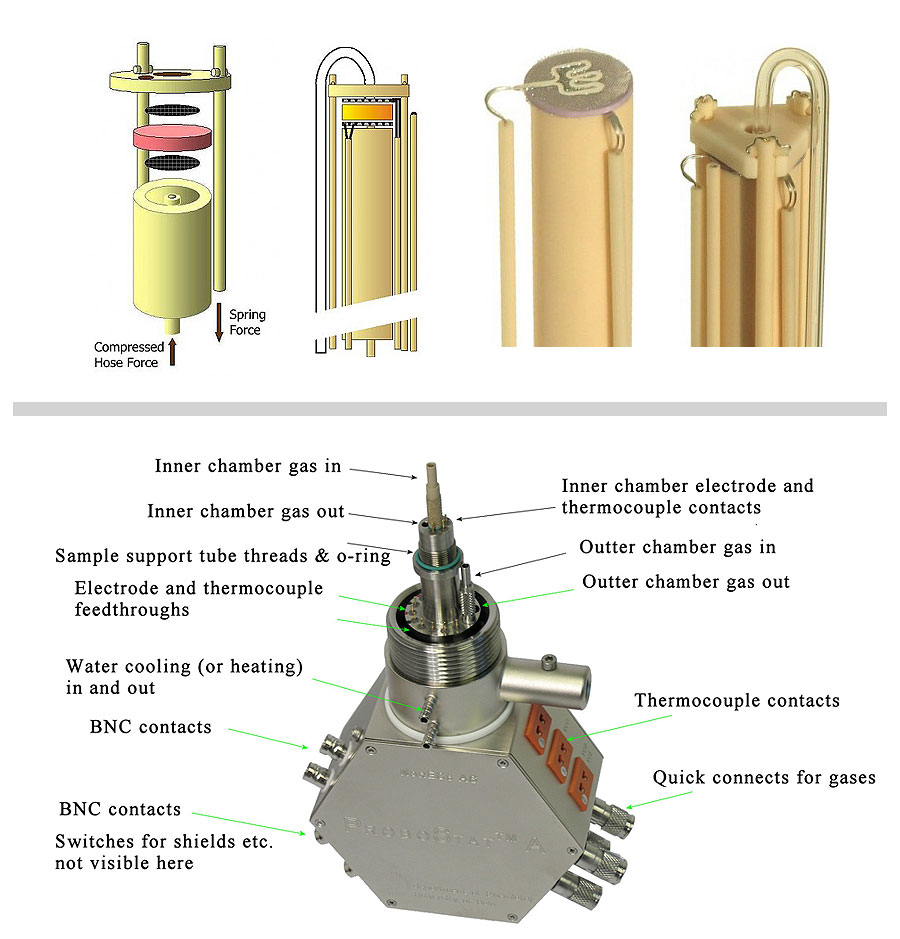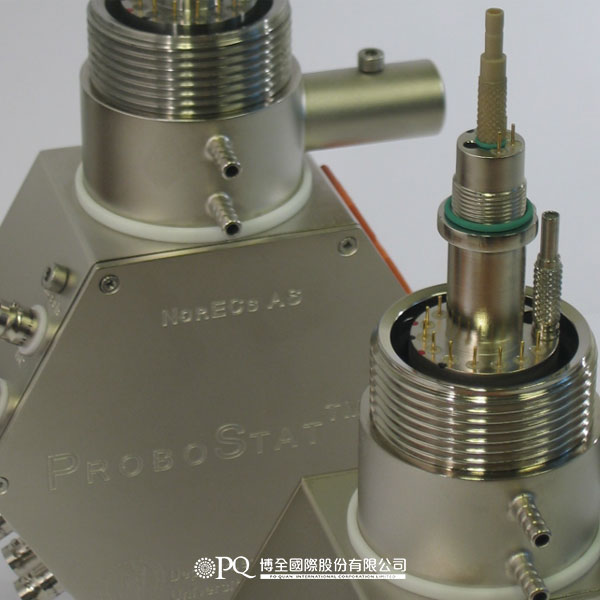燃料電池測試系統概要
ProboStat, overview-
Brief description
The sample under test rests on a ca. 50 cm long support tube of alumina, inside a closed outer tube of alumina or silica. The sample can be contacted with 2, 3 or 4 electrodes of e.g. platinum, using disk, van der Pauw, or bar geometries. A spring-loaded alumina assembly holds the sample and electrodes in place. 16 electrical feedthroughs allow use of 4 shielded electrode leads, surface guard, and up to three thermocouples (e.g. for Seebeck coefficient measurements). Electrical connections are made via coax cables suitable for standard impedance spectrometer connectors, and standard thermocouple compensation cables. Gases can be fed in single or dual chamber modes directly onto or from electrodes, allowing measurements under controlled atmospheres, transport number measurements in gradients, and testing of fuel cell, pump, and sensor components. Gas supply is via Swagelok quick-connects.
Materials properties measured and applicable methods
- Conductivity vs T, pO2, pH2O, etc.
- DC, AC, impedance spectroscopy
- Dielectric properties, loss, etc.
- Disk, van der Pauw, and bar geometries
- 2, 3, and 4 electrodes
- Ionic transport number
- Proton transport number
- H/D isotope effects
- Seebeck coefficient
- I-V-characteristics
- Fuel cell components and single cell testing
- Electrode kinetics
- Electrochemical pumping, gas permeation and electrocatalysis with gas analysis (e.g. GC or MS) on outlets
- Sensor testing
- Poling of ferroelectrics possible with the high-voltage (kV) version
- High-current version
- Annealing or sintering under controlled atmosphere

-
- Outer tube diameter: 40 mm
- Overall length: 75 cm, shorter versions available (-10, -20, -30 cm)
- Single end cell assembly
- Sample fixation: spring force via alumina rods
- All hot-zone electrode leads detachable via feedthrough mini-connectors
- Support tube systems from 10 to 24 mm diameter detachable
- For up to 24 mm diameter disk samples
- For up to 50 mm long bar samples
- Temperature: typical long term: < 1400ºC, short term: < 1600ºC
- Atmosphere: Oxidizing, reducing, or corrosive; wet or dry; from small overpressure to low vacuum
- 6 BNC electrode connections for impedance spectrometers etc.
- Internal shields bridging, ground and guard switches
- 3 thermocouple connections
- 4 Swagelok gas quick-connects to 1/8'' tubing (other connections on request)
- Standard materials: Alumina AL23, Pt, Pt10%Rh, Ni-plated brass
- Water cooling (or heating) of cold end base unit is possible
- Spare parts supply, also of hot zone consumables
- 16 electric feedthroughs (4 inner chamber, 12 outer chamber). Rated for 100V, 5A each
-
Brief description
The sample under test rests on a ca. 50 cm long support tube of alumina, inside a closed outer tube of alumina or silica. The sample can be contacted with 2, 3 or 4 electrodes of e.g. platinum, using disk, van der Pauw, or bar geometries. A spring-loaded alumina assembly holds the sample and electrodes in place. 16 electrical feedthroughs allow use of 4 shielded electrode leads, surface guard, and up to three thermocouples (e.g. for Seebeck coefficient measurements). Electrical connections are made via coax cables suitable for standard impedance spectrometer connectors, and standard thermocouple compensation cables. Gases can be fed in single or dual chamber modes directly onto or from electrodes, allowing measurements under controlled atmospheres, transport number measurements in gradients, and testing of fuel cell, pump, and sensor components. Gas supply is via Swagelok quick-connects.
Materials properties measured and applicable methods
- Conductivity vs T, pO2, pH2O, etc.
- DC, AC, impedance spectroscopy
- Dielectric properties, loss, etc.
- Disk, van der Pauw, and bar geometries
- 2, 3, and 4 electrodes
- Ionic transport number
- Proton transport number
- H/D isotope effects
- Seebeck coefficient
- I-V-characteristics
- Fuel cell components and single cell testing
- Electrode kinetics
- Electrochemical pumping, gas permeation and electrocatalysis with gas analysis (e.g. GC or MS) on outlets
- Sensor testing
- Poling of ferroelectrics possible with the high-voltage (kV) version
- High-current version
- Annealing or sintering under controlled atmosphere
Example of connection to disk samples for impedance measurements. The schematics show principle of spring loads and regular 2-electrode 4-wire setup with dual gas supplies and thermocouple. Part of base unit with feedthroughs is shown in the photo below. 
-
- Outer tube diameter: 40 mm
- Overall length: 75 cm, shorter versions available (-10, -20, -30 cm)
- Single end cell assembly
- Sample fixation: spring force via alumina rods
- All hot-zone electrode leads detachable via feedthrough mini-connectors
- Support tube systems from 10 to 24 mm diameter detachable
- For up to 24 mm diameter disk samples
- For up to 50 mm long bar samples
- Temperature: typical long term: < 1400ºC, short term: < 1600ºC
- Atmosphere: Oxidizing, reducing, or corrosive; wet or dry; from small overpressure to low vacuum
- 6 BNC electrode connections for impedance spectrometers etc.
- Internal shields bridging, ground and guard switches
- 3 thermocouple connections
- 4 Swagelok gas quick-connects to 1/8'' tubing (other connections on request)
- Standard materials: Alumina AL23, Pt, Pt10%Rh, Ni-plated brass
- Water cooling (or heating) of cold end base unit is possible
- Spare parts supply, also of hot zone consumables
- 16 electric feedthroughs (4 inner chamber, 12 outer chamber). Rated for 100V, 5A each








